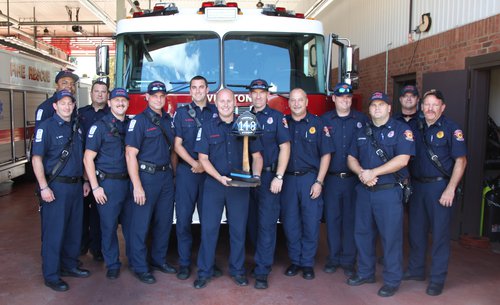COVINGTON, Ga. – Firefighters will respond to hundreds of emergency medical calls over the course of their careers. They develop an ability to put most of those calls - even the most gruesome ones - behind them. If they don’t, they might not be able to respond to the next one. It’s a fact of the job.

Occasionally there are calls they can’t leave behind. Those calls might involve a family member or a particularly heinous crime against a child. Or they might involve a buddy.
The Covington Fire Department’s B-Shift was on duty Sept. 3. Both city stations responded when Covington Police Department Officer Matt Cooper was shot. Their actions that day and the emergency medical care Officer Cooper received in the immediate aftermath of the shooting have been credited with helping save his life.
But the firefighters weren’t able to leave the call on Industrial Boulevard behind. They wanted to continue to do what they could for their wounded friend. They channeled their concern and desire to do more into a moving tribute that they plan to present to Officer Cooper.
Firefighter III Evan McAvoy said the idea came about when Fire Chief Jeremy Holmes inquired about making a fire helmet shield for the wounded officer.
“We were sitting actually sitting in the day room eating lunch,” McAvoy said. "And my captain said, ’Hey, did you bring your leatherworking skills with you today?’ And I said ‘maybe, why are you wanting to know?‘
“And he said ‘Chief Holmes wants to know if you can make a shield for a helmet that is themed along the lines of Matt Cooper, Covington Fire, the thin blue line kind of police support that everybody has seen for a long time, but he wanted the fire department incorporated into it as well.
“We’re two departments but we play for the same team.”
McAvoy, who makes fire helmet shields for other firefighters, said he had been looking for something he could do to show support for the wounded officer. He said the helmet shield was a perfect idea.
“I was actually sitting thinking about it and I was thinking it’d be neat if I could do something with my leatherworking. I was thinking, ‘God if there’s anything I can do, show it to me,” he said. “I just couldn’t think of anything. Nothing was coming to mind.
“When Chief Holmes mentioned something to Captain Tanner who said something to me about it, I was like, that’s perfect. Can I get started on it right now?”
McAvoy said the project evolved into a team effort.
“At first, it was I want to do a shield for Matt. We can just find a helmet and put it on it,” he said. “And then between myself, Chief Holmes, some of the other administrative staff here and the guys on my shift, we basically sat down and asked how can we make an entirely police themed fire helmet? How is that possible?”
The helmet includes reflective blue tetrahedrons and a shield with Officer Cooper’s badge number and the words “Cooper Strong”. There is a leather helmet band with a thin blue line emblazoned with “Covington Fire”. The helmet sits on a fire ax with another blue line.
McAvoy said they considered putting a thin red line representing the fire service behind the “Covington Fire” but went with the blue to show support for Officer Cooper and CPD.
“This whole thing is for Matt, for the police department, to show that we’re supporting them in their time of need,” he said. “It ended up with the whole helmet going with the blue and black theme.”
McAvoy talked about what working on the helmet meant for the firefighters involved in its creation.
“When you go through EMT school and the fire academy and you run calls here and there and you’re like, ‘Man, I helped their day go better and I did my job’, you come back the station and you don’t think about it anymore,” he said.
“But then you get dispatched to a call and it’s somebody you know. It’s not just I know their name or I’ve seen them before, but you know them and you’ve seen their family. You’ve run calls together and joked around and seen each other off shift and talked and you get back from that call and you start thinking ‘could I have done more?’
‘You’re supposed to leave everything at the call, but sometimes you can’t. You bring it back with you. And just when you think that you’ve done all you can do and it’s time to stop and let the doctors do what they can do, still in your heart, you’re wanting to be able to do more.
“So when the opportunity does come that you can do something like this, that’s more than what you did out there on the scene, that you can continue the effort to show that a week after the call, a month after the call, ten years after the call that we’re always going to be there- us for the police department and them for us as well.”





